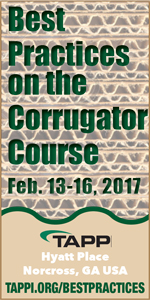 |
||||||||
| February 1, 2017 | ||||||||
| iRoll Portable press nip analysis at Cartiere del Garda |  |
|||||||
|
· Subscribe to Ahead of the Curve · Newsletters · Ahead of the Curve archived issues · Contact the Editor
|
Getting the most from safety inspections JAY SHELLOGG I enjoyed reading Graeme Rodden’s article “Know the State of Your Emergency Showers” in the Jan/Feb issue of Paper360°. I read it with a since of urgency, and reached out to a colleague of mine, Carlo Odoardi, to help me write this response. The first step in correcting any problem is recognizing that you have a problem. In the article, Rodden quotes a presentation made by Larry Kilian of Haws at the recent PPSA conference. The article lays out the problem perfectly: “on average, only 25 percent of emergency shower/eye wash stations work properly and can provide proper first aid – despite weekly or monthly checks.” In his presentation, Kilian calls out many possible reasons for non-conformance of emergency shower/eye wash stations, including such things as obstructed access, too much or too little flow, or no dust covers. To be sure, there are many more causes of failure, but determining those are better left to the Subject Matter Experts (SMEs)—the users of the systems. In this article, I instead want to address two points: 1) How to determine what we must do to insure our system does what we want it to do; 2) What tolerable availability we are willing to accept, and what actions get us there. Tolerable availability One way we can arrive at the testing frequency is by understanding what availability we require and what the failure rate is. Let us start with what I believe is a straightforward idea: The more often we check if something is working, the higher we drive its availability.
As an example, you cannot know if an E-Stop works unless you check it. If you check once a month, all you can be assured of is that it was working (or not) the last time you checked. The more often you check (say daily), and repair any failures, the less time it will be in a failed state. Said another way, if you check it monthly, the longest it can be failed is 30 days; if you check it daily, the longest it can be failed is 24 hours. The more checks, the more availability. The question is, “IS THIS GOOD ENOUGH?” Maybe, but not likely. We know that the more often we check something, the higher we drive its availability, but what can we do if increasing the rate of inspection is not practical? We change the failure rate, as the article suggests, with better inspections. Not necessarily more, but better. There is something else we can do—decrease the demand rate on the shower. This means that we train our employees and maintain our process to diminish the need for the shower. Getting the system to do what we want We tend to think that similar equipment can be managed the same way; however, causes of shower failure in the woodyard, bleach plant, recaust, or paper machines are all different. Have you ever seen a shower in the woodyard caked with lime dust, or a shower in the basement of a paper machine buried in fines, or a shower in the bleach plant obstructed with core buggies? Even though showers are very similar, when they are operated in different parts of the mill the maintenance strategy must be tailor-fitted for each area. In my experience, mills inspect all of the site’s identical showers with the same frequency, using the same parameters. We need to be prescriptive to each shower. This will improve our availability.
1. We gather a team of the potential users of the shower and anyone else who has something legitimate to say about its management. These are the SMEs. Let’s look back at the reasons cited in the article—no dust covers—and run it through the steps above. One possible solution might be as follows:
• Function: The primary function of an eye wash is to provide wash water of a flow rate greater than 0.4 gal/min and less than 0.5 gal/min. It is important to recognize that the solution above is for example only and can in no way be taken as prescriptive. With each step there are several possible solutions depending on the operating context of the eye wash, and this article cannot possibly predict operating context. For example, if the failure mode had been “dust covers missing due to degradation of the plastic”, under “failure effect” we might have noted that, over time the plastic degrades, cracks propagate through the cover, and the cover falls off. In this case, with the help of the team, we have a proactive maintenance task: we look for the cracks beginning to develop. We would set our inspection frequency for half the time it takes between recognizing the cracks forming and the cover dropping off. Finally, only the subject matter experts—the users/maintainers/owners of the showers—can determine this strategy. Consultants, contractors, and engineers can help—but only the mill’s SMEs are the true experts. Conclusion
Thanks to Graeme Rodden and Larry Kilian for the interesting article and presentation that prompted this reply. I also want to thank Carlo Odoardi of COCO NET Inc. (coconetinc.wordpress.com) for helping me with this article, performing a peer review, and editing. If you have any questions or would like any details around this process please feel free to contact either Carlo (carlo.odoardi@cogeco.ca) or Jay (jayshellogg@strategicmaint.com). About the author: For a modest investment of $174, receive more than US$ 1000 in benefits in return. Visit www.tappi.org/join for more details. |
|||||||
 |
||||||||
